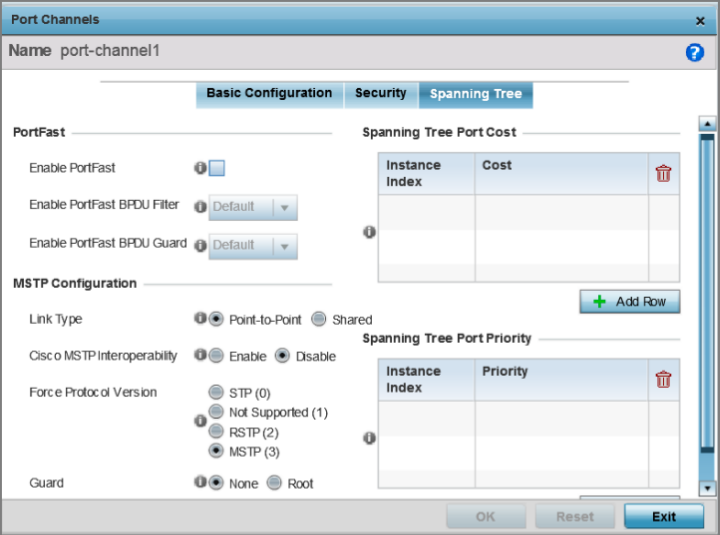Profile Overrides - Spanning Tree Configuration (AP Only)
About this task
To override port channel spanning tree configurations:
Procedure
-
Select the Spanning Tree
tab.
The port channel spanning tree configuration screen displays.
 Port Channel - Spanning Tree Configuration Screen
Port Channel - Spanning Tree Configuration Screen
-
Define or override the following
PortFast
parameters for the port channel‘s MSTP configuration:
Enable PortFast
Select to enable drop-down menus for the Enable PortFast BPDU Filter and Enable PortFast BPDU Guard options. This option is disabled by default.
PortFast reduces the time required for a port to complete a MSTP state change from Blocked to Forward. PortFast must only be enabled on ports on the wireless controller directly connected to a server/workstation and not another hub or controller. PortFast can be left unconfigured on an access point.
Enable PortFast BPDU Filter
Enable PortFast to invoke a BPDU filter for this portfast enabled port channel. Enabling the BPDU filter feature ensures this port channel does not transmit or receive any BPDUs. The options are:-
Default — This is the default setting. This option makes the bridge BPDU filter value to take effect.
-
Enable — Enables BPDU filtering.
-
Disable — Disables BPDU filtering.
Enable PortFast BPDU Guard
Enable PortFast to invoke a BPDU guard for this portfast enabled port channel. Enabling the BPDU guard feature means this port will shutdown on receiving a BPDU. Hence no BPDUs are processed. The options are:-
Default — This is the default setting. This option makes the bridge BPDU guard value to take effect.
-
Enable — Enables shutting down of port.
-
Disable — Disables shutting down of port.
-
-
Set or override the following
MSTP
Configuration parameters for the port channel:
Link Type
Select one of the following link type options:-
Point-to-Point - Select to configure the port as connected to a point-to-point link.
-
Shared - Select to configure the port as having a shared connection.
Note:A port connected to a hub is on a Shared link. Whereas, a port connected to a controller or service platform is a Point-to-Point link.
Point-to-Point is the default setting.
Cisco MSTP Interoperability
Select to Enable or Disable interoperability with Cisco‘s version of MSTP over the port. Cisco's version of MSTP is incompatible with standard MSTP. This default setting is Disable.
Force Protocol Version
Set the protocol version to either STP(0), Not Supportedd(1), RSTP(2), or MSTP(3). The default setting is MSTP(3).
Guard
Determines whether the port channel enforces root bridge placement. Setting the guard to Root ensures the port is a designated port. Typically, each guard root port is a designated port, unless two or more ports (within the root bridge) are connected together. If the bridge receives superior (BPDUs) on a guard root-enabled port, the guard root moves the port to a root-inconsistent STP state. This state is equivalent to a listening state. No data is forwarded across the port. Thus, the guard root enforces the root bridge position.
-
-
Refer to the Spanning Tree Port
Cost table.
Define or override an Instance Index using the spinner control, and set its corresponding cost in the Cost column. The default path cost depends on the user defined port speed. The cost helps determine the role of the port channel in the MSTP network.
The designated cost is the cost for a packet to travel from this port to the root in the MSTP configuration. The slower the media, higher the cost.
Table 1. Spanning Tree Port Cost Speed
Default Path Cost
<=100,000 bits/sec
200000000
<=1,000,000 bits/sec
20000000
<=10,000,000 bits/sec
2000000
<=100,000,000 bits/sec
200000
<=1,000,000,000 bits/sec
20000
<=10,000,000,000 bits/sec
2000
<=100,000,000,000 bits/sec
200
<=1,000,000,000,000 bits/sec
20
>1,000,000,000,000 bits/sec
2
Select + Add Row as needed to include additional indexes.
-
Refer to the Spanning Tree Port
Priority table.
Define or override an Instance Index using the spinner control, then set the Priority. The lower the priority, the greater likelihood of the port becoming a designated port.
Select + Add Row as needed to include additional indexes.
-
Click OK to save the
changes and overrides made to the Ethernet port's Spanning Tree configuration.
Click Reset to revert to the last saved configuration.


